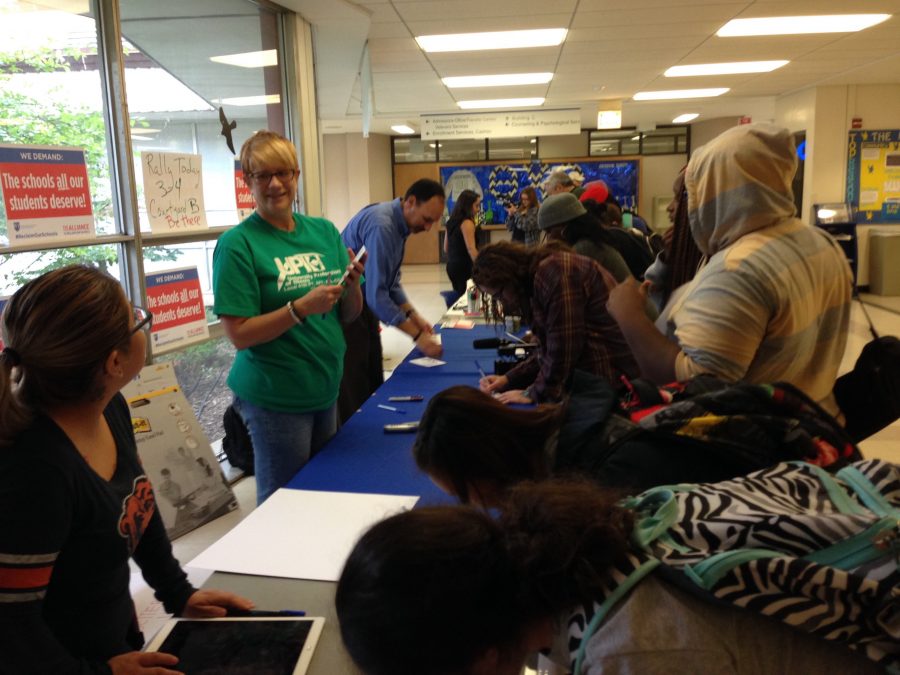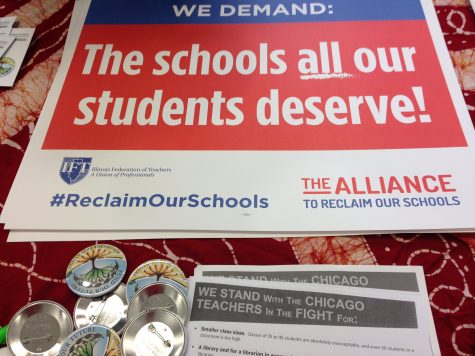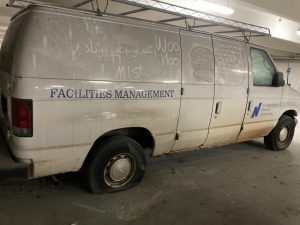NEIU students tell lawmakers to fund education
Dr. Nanette Potee interacts with students who gathered and signed their names to support the rally’s cause.
October 25, 2016
Halloween came a few weeks early for Northeastern Illinois University students. Donning masks of Mayor Rahm Emanuel and Gov. Bruce Rauner, students snapped photos to tweet and Instagram with the hashtags, #ReclaimOurSchools, #FundOurFuture, #LostWithoutMAP and #BruceBetterHaveOurMoney, highlighting the scary state of public K-12 and higher education.
As part of the Oct. 6 nationwide Day of Action, sponsored by the Alliance to Reclaim Our Schools, faculty, staff, union members, students and community-based activists sponsored tables where students could register to vote, sign postcards to their state lawmakers demanding full funding for education and get their photo taken with or without a scary Rahm or Rauner mask.
Alexis Hall, 23 and a freshman, stopped by to register to vote. The cuts to public universities and the state budget crisis have pushed her to the brink of leaving the state to return to her hometown Columbus, Ohio. Because of lawmakers and the governor’s inability to reach a compromise on the budget, Illinois has entered its second year without one.
A stop-gap appropriations bill to allocate some funding for higher education was passed to avert total calamity befalling the state’s public universities. For Hall, that meant her Monetary Assistance Program — called MAP grants — was cut in half.
“I had to pay for tuition and books, and I work a minimum wage job. You can only imagine how many books I had to pay for with four classes,” she said. “You know it’s not easy with a minimum wage job. Everything is so expensive here. It’s also disheartening. I thought they would find a way to retain students.”
According to Crain’s, professors are leaving the state by the droves and students are too. “Nobody wants to touch Illinois with a 10-foot pole right now,” Tanya Cofer, a Northeastern Illinois University math teacher told Crain’s. She and her husband and colleague, Isidor Ruderfer, are leaving the state to take jobs in Georgia.
University administrators have worked with faculty and staff unions, lobbying lawmakers for full funding. NEIU Interim President Richard Helldobler opened the afternoon rally for education, welcoming union members, students, faculty and staff “in the spirit of solidarity.”
He said whether it is “elementary, secondary or higher education, there is one thing we share in common. That is dedication to our students and the state of Illinois.” Part of the day’s theme was solidarity with the Chicago Teachers Union and K-12 public schools. Many thought the union would be forced to strike, but a tentative agreement was reached just before the Oct. 11 strike deadline.
John Miller, president of University Professionals of Illinois, drew a sharp contrast between the higher education community and the governor. Despite Rauner’s praise for the budget band-aid called the stopgap measure, Miller said it was a failure because it actually slashed higher education funding.
“They have voted to cut every single public university, every college by 40 percent,” he said. “And guess what they left out of that bill. Your MAP funding for the current academic year.”
Miller said the state has lost a lot of students and enrollment has plummeted by 25 percent or more in some higher education institutions.
Melanie and Valerie Gorny are studying social work. They said they are not among the 130,000 MAP grantees statewide, yet the funding cuts and budget crisis still affects their education and future.
“Lack of a budget would shut down our school,” Valerie Gorny said.
“It affected teachers who had to take furloughs. It affected class times and scheduling and therefore our learning,” Melanie Gorny said.
Political action was a major theme throughout the day. Chaelecia Cooper, an AFSCME board member, NEIU employee and mother of four, urged everyone to get out and vote Nov. 8.
“At what point are we going to say, ‘Enough is enough!’ When are we going to get off of our duffs and do something? We need to have people in office that actually can relate to the importance of an education and speak for the people. We cannot keep cutting services, and we cannot keep closing schools,” Cooper said.
In addition to presidential candidates and congressional representatives, state lawmakers will be on the ballot this November. “You can make a difference. Do your research. Be informed about your legislators and what decisions they are making on your behalf,” Cooper said.
State Rep. Will Guzzardi echoed Hillary Clinton’s platform to create tuition and debt-free education and announced a new campaign to make state colleges and universities free.
“We have a plan to pay for it. Raise taxes on the very wealthy in Illinois and close corporate loopholes,” he said.
“Bruce Rauner and Donald Trump and all the rest of those guys who think they’re so smart for not paying taxes, we hold them accountable to pay their fair share and use the billions of dollars to lift up everyone.”







